Typhoon Ragasa: Hong Kong Observatory on High Alert
Super Typhoon Ragasa is currently making headlines as it barrels towards China, after lashing Taiwan and bringing Asian megacities to a standstill. The Hong Kong Observatory Typhoon tracking and prediction efforts are now more critical than ever. Understanding how the Observatory operates and what measures are put in place can make all the difference in ensuring safety and minimizing potential damage. In this comprehensive guide, we’ll delve into the inner workings of the Hong Kong Observatory, its role in typhoon monitoring, and practical steps you can take to prepare for such extreme weather events.
This article covers everything from understanding the Observatory’s warning signals to actionable tips on how to safeguard your home and business. Let’s dive in and get you prepared.

Understanding the Hong Kong Observatory
The Hong Kong Observatory (HKO) is the government department responsible for monitoring weather and issuing warnings on weather-related hazards. Established in 1883, it plays a vital role in protecting the lives and property of the people of Hong Kong and surrounding regions. Its responsibilities extend beyond typhoons to include rainfall, thunderstorms, and even aviation weather services.
The Observatory’s Mission and Responsibilities
- Weather Forecasting: Providing accurate and timely weather forecasts to the public and various sectors, including aviation and marine transport.
- Typhoon Monitoring: Tracking and predicting the path and intensity of tropical cyclones in the Western North Pacific and South China Sea.
- Warning Services: Issuing warnings for severe weather phenomena, such as typhoons, rainstorms, thunderstorms, and landslips.
- Climate Monitoring: Monitoring long-term climate trends and providing climate change projections.
- Public Education: Promoting public awareness of weather-related hazards and providing guidance on preparedness measures.
How the Hong Kong Observatory Tracks Typhoons
The HKO uses a variety of sophisticated tools and techniques to track and predict the behavior of typhoons. These include:
- Weather Satellites: Geostationary and polar-orbiting satellites provide continuous images of cloud patterns and atmospheric conditions.
- Weather Radar: Radar systems detect rainfall intensity and distribution, helping to identify the location and movement of typhoon rainbands.
- Surface Weather Stations: A network of weather stations across Hong Kong and surrounding areas collects data on wind speed, temperature, pressure, and rainfall.
- Upper-Air Soundings: Radiosondes are launched into the atmosphere to measure temperature, humidity, and wind at different altitudes.
- Numerical Weather Prediction Models: Powerful computer models simulate the atmosphere and predict future weather conditions.
The combination of these tools allows the HKO to provide timely and accurate warnings, giving the public ample time to prepare. For more information on predicting future weather, see our guide to AI in weather forecasting.
Typhoon Warning Signals: A Clear and Present Danger
The Hong Kong Observatory uses a numbered system of typhoon warning signals to indicate the severity of the threat. Understanding these signals is crucial for taking appropriate action.
Understanding the Signal System
- Standby Signal, No. 1: A tropical cyclone is within 800 km of Hong Kong and may affect the territory.
- Strong Wind Signal, No. 3: Strong winds are expected or blowing generally near sea level, and may affect Hong Kong.
- Gale or Storm Signal, No. 8: Gale or storm force winds are expected or blowing generally near sea level. This signal is further subdivided into Northeast, Southeast, Northwest, and Southwest signals to indicate the expected wind direction.
- Increasing Gale or Storm Signal, No. 9: Gale or storm force winds are increasing significantly or expected to increase significantly.
- Hurricane Signal, No. 10: Hurricane force winds are expected or blowing generally near sea level.
What Each Signal Means for You
Each signal level requires different actions. Here’s a breakdown:
- Signal No. 1: Stay informed about the latest weather updates.
- Signal No. 3: Secure outdoor objects, check windows and doors, and avoid exposed areas.
- Signal No. 8: Most businesses and schools will close. Stay indoors and away from windows. Avoid non-essential travel.
- Signal No. 9 & 10: Take all necessary precautions. Stay indoors and away from windows. Expect severe conditions. Monitor official announcements from the Hong Kong Observatory.
Staying informed through the HKO website, mobile app, and local news channels is paramount during a typhoon. Also, understanding your vulnerability to weather events is crucial, much like understanding your business’s vulnerability to cyberattacks. For more information on this, see our guide to cybersecurity basics.
Preparing for a Typhoon: Practical Tips and Actionable Steps
Being prepared is the best defense against the potential devastation of a typhoon. Here are some practical steps you can take to protect yourself, your family, and your property.
Home Preparedness
- Secure Windows and Doors: Board up windows or use storm shutters. Reinforce doors and frames.
- Trim Trees and Shrubs: Remove any branches that could fall and cause damage.
- Clear Gutters and Drains: Ensure proper drainage to prevent flooding.
- Prepare an Emergency Kit: Include food, water, medications, a flashlight, a radio, and a first-aid kit.
- Know Your Evacuation Route: If you live in a low-lying area, be aware of evacuation routes and shelters.
Business Preparedness
- Develop a Business Continuity Plan: Outline procedures for protecting assets, data, and employees. Consider data backup and recovery strategies.
- Secure Equipment and Inventory: Move valuable items to higher ground and secure any outdoor equipment.
- Communicate with Employees: Keep employees informed about typhoon warnings and safety procedures.
- Backup Critical Data: Ensure that all critical data is backed up and stored in a secure location.
- Review Insurance Policies: Make sure your insurance coverage is adequate for potential damage.
Preparing for a typhoon also involves creating a robust communication strategy. In today’s digital age, this means leveraging various channels to reach your audience. For more insights on this, check out our comprehensive guide to digital marketing strategies.
Staying Safe During a Typhoon
- Stay Indoors: The safest place to be during a typhoon is indoors, away from windows and doors.
- Monitor Weather Updates: Stay informed about the latest developments from the Hong Kong Observatory and other reliable sources.
- Avoid Coastal Areas: Stay away from beaches, cliffs, and other coastal areas that are vulnerable to storm surge.
- Conserve Water and Power: Typhoons can disrupt essential services. Conserve water and power as much as possible.
- Be Prepared for Power Outages: Have flashlights, batteries, and a backup power source if possible.
The Impact of Climate Change on Typhoons
Climate change is expected to exacerbate the intensity and frequency of typhoons. Rising sea temperatures provide more energy for storms to develop, leading to stronger winds and heavier rainfall. Sea level rise also increases the risk of coastal flooding.
How Climate Change Affects Typhoon Patterns
- Increased Intensity: Warmer ocean temperatures fuel stronger typhoons with higher wind speeds and heavier rainfall.
- Sea Level Rise: Higher sea levels increase the risk of coastal flooding during storm surges.
- Changes in Tracks: Climate change may alter the tracks of typhoons, potentially affecting areas that are not typically exposed to these storms.
- More Frequent Extreme Events: We can expect more frequent occurrences of extreme weather events like Super Typhoon Ragasa.
The Importance of Sustainable Practices
Reducing greenhouse gas emissions and adopting sustainable practices is crucial for mitigating the impacts of climate change and reducing the long-term risk of typhoons. Individuals, businesses, and governments all have a role to play in addressing this global challenge.
Implementing sustainable practices is not just about environmental responsibility; it’s also about long-term business resilience. This is similar to implementing proper SEO best practices to ensure your website remains competitive in the long run.
Conclusion: Staying Informed and Prepared
Typhoons are a significant threat in Hong Kong and the surrounding regions. By understanding the role of the Hong Kong Observatory Typhoon monitoring and warning systems, and by taking proactive steps to prepare, you can significantly reduce the risk to yourself, your family, and your business. Stay informed, stay prepared, and stay safe.
Now that you understand the importance of preparedness, take action today! Review your emergency plan, update your supplies, and share this information with your friends and family. Together, we can build a more resilient community.









